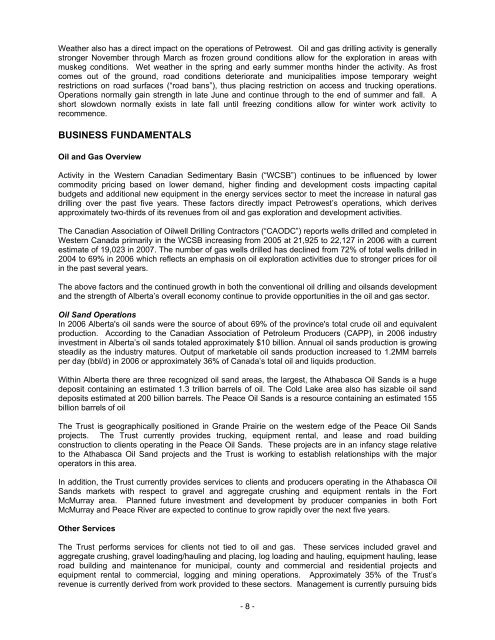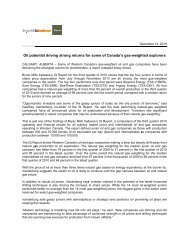Weather also has a direct impact on the operations <strong>of</strong> Petrowest. Oil and gas drilling activity is generallystronger November through March as frozen ground conditions allow for the exploration in areas withmuskeg conditions. Wet weather in the spring and early summer months hinder the activity. As frostcomes out <strong>of</strong> the ground, road conditions deteriorate and municipalities impose temporary weightrestrictions on road surfaces (“road bans”), thus placing restriction on access and trucking operations.Operations normally gain strength in late June and continue through to the end <strong>of</strong> summer and fall. Ashort slowdown normally exists in late fall until freezing conditions allow for winter work activity torecommence.BUSINESS FUNDAMENTALSOil and Gas OverviewActivity in the Western Canadian Sedimentary Basin (“WCSB”) continues to be influenced by lowercommodity pricing based on lower demand, higher finding and development costs impacting capitalbudgets and additional new equipment in the <strong>energy</strong> <strong>services</strong> sector to meet the increase in natural gasdrilling over the past five years. These factors directly impact Petrowest’s operations, which derivesapproximately two-thirds <strong>of</strong> its revenues from oil and gas exploration and development activities.The Canadian Association <strong>of</strong> Oilwell Drilling Contractors (“CAODC”) reports wells drilled and completed inWestern Canada primarily in the WCSB increasing from 2005 at 21,925 to 22,127 in 2006 with a currentestimate <strong>of</strong> 19,023 in 2007. The number <strong>of</strong> gas wells drilled has declined from 72% <strong>of</strong> total wells drilled in2004 to 69% in 2006 which reflects an emphasis on oil exploration activities due to stronger prices for oilin the past several years.The above factors and the continued growth in both the conventional oil drilling and oilsands developmentand the strength <strong>of</strong> Alberta’s overall economy continue to provide opportunities in the oil and gas sector.Oil Sand OperationsIn 2006 Alberta's oil sands were the source <strong>of</strong> about 69% <strong>of</strong> the province's total crude oil and equivalentproduction. According to the Canadian Association <strong>of</strong> Petroleum Producers (CAPP), in 2006 industryinvestment in Alberta’s oil sands totaled approximately $10 billion. Annual oil sands production is growingsteadily as the industry matures. Output <strong>of</strong> marketable oil sands production increased to 1.2MM barrelsper day (bbl/d) in 2006 or approximately 36% <strong>of</strong> Canada’s total oil and liquids production.Within Alberta there are three recognized oil sand areas, the largest, the Athabasca Oil Sands is a hugedeposit containing an estimated 1.3 trillion barrels <strong>of</strong> oil. The Cold Lake area also has sizable oil sanddeposits estimated at 200 billion barrels. The Peace Oil Sands is a resource containing an estimated 155billion barrels <strong>of</strong> oilThe Trust is geographically positioned in Grande Prairie on the western edge <strong>of</strong> the Peace Oil Sandsprojects. The Trust currently provides trucking, equipment rental, and lease and road buildingconstruction to clients operating in the Peace Oil Sands. These projects are in an infancy stage relativeto the Athabasca Oil Sand projects and the Trust is working to establish relationships with the majoroperators in this area.In addition, the Trust currently provides <strong>services</strong> to clients and producers operating in the Athabasca OilSands markets with respect to gravel and aggregate crushing and equipment rentals in the FortMcMurray area. Planned future investment and development by producer companies in both FortMcMurray and Peace River are expected to continue to grow rapidly over the next five years.Other ServicesThe Trust performs <strong>services</strong> for clients not tied to oil and gas. These <strong>services</strong> included gravel andaggregate crushing, gravel loading/hauling and placing, log loading and hauling, equipment hauling, leaseroad building and maintenance for municipal, county and commercial and residential projects andequipment rental to commercial, logging and mining operations. Approximately 35% <strong>of</strong> the Trust’srevenue is currently derived from work provided to these sectors. Management is currently pursuing bids- 8 -
or negotiations on work tied to a number <strong>of</strong> these planned projects and is optimistic that the Trust will besuccessful in future participation on many <strong>of</strong> the projects.Based on 2005 Alberta government statistics, forests cover more than 60% <strong>of</strong> Alberta's total land base,equal to approximately 94 <strong>million</strong> acres or almost 147,000 square miles. Of this land base, 87% is onpublic lands and managed for sustainable development with over 75 <strong>million</strong> seedlings planted every yearto sustain the forests. Alberta Forest Products Association estimates Alberta's forest sector generates$8.4 billion in revenues with growth expectations <strong>of</strong> approximately 0.4% annually from 2005 to 2010. Asat December 31, 2006 there were approximately 5 major forestry related projects proposed or underwayin the Peace River region, the Trust’s primary operation area. These projects totaled approximately $490<strong>million</strong> dollars <strong>of</strong> which approximately 90% <strong>of</strong> the project values are being undertaken by clients the Trustcurrently works for.As <strong>of</strong> December 2006, according to statistics released by the Alberta government, there areapproximately 135 major projects proposed or underway in the Peace River Region. The value <strong>of</strong> theseprojects is approximately $1.19 billion, although it is reasonable to expect that not all proposed projectswill proceed. A large number <strong>of</strong> these projects will requires <strong>services</strong> the Trust is able to provide includinggravel crushing and supply, gravel hauling and road and site construction.ACQUISITIONSThe Trust was formed by a deed <strong>of</strong> <strong>trust</strong> dated July 6, 2006. Pursuant to a prospectus dated August 28,2006 the Trust issued units and used the proceeds, through its subsidiaries, to acquire 100% <strong>of</strong> theoutstanding shares <strong>of</strong> the Acquired Companies described in Note 4 to the March 31, 2007 interimunaudited financial statements. The estimated purchase price <strong>of</strong> the Acquired Companies wasapproximately $258.0 <strong>million</strong> including post closing adjustments for actual working capital acquired andthe actual Acquired Companies’ debt balances retired on the acquisition. The purchase price was fundedby payment <strong>of</strong> approximately $107.6 <strong>million</strong> net cash payable to the vendors, $22.7 <strong>million</strong> retirement <strong>of</strong>debt and the issuance <strong>of</strong> units by the Trust for proceeds <strong>of</strong> $127.7 <strong>million</strong>,. In conjunction with theacquisitions, all debt and capital lease obligations were repaid by Petrowest through the use <strong>of</strong> proceedsfrom the <strong>of</strong>fering.There is currently a dispute with Northern Tractor associated with the valuation <strong>of</strong> certain working capitalitems and the valuation <strong>of</strong> redundant assets retained by the vendor. The total disputed amount isapproximately $3.7 <strong>million</strong> <strong>of</strong> which the <strong>trust</strong> has collected to date approximately $2.9 <strong>million</strong> associatedwith amounts in dispute. Arbitration <strong>of</strong> these amounts is expected to occur prior to the end <strong>of</strong> the thirdquarter <strong>of</strong> 2007 and adjustments required to the purchase price, if any, may be material.SUBSEQUENT EVENTSOn May 9, 2007 Petrowest entered into agreements to acquire all <strong>of</strong> the outstanding shares andshareholder loans <strong>of</strong> Cutbank Trucking Ltd. and Cutbank Transport Ltd. (collectively, “Cutbank”), JimM<strong>of</strong>fatt Construction Ltd. and 921639 Alberta Ltd., (collectively, “Jim M<strong>of</strong>fatt Construction”), QuigleyContracting Ltd, 529805 B.C. Ltd. and LMQ Enterprises Ltd., (collectively, “Quigley Contracting Ltd.”),Rick's Mechanical Services Ltd. and Tri-Dave Gravel Sales Ltd (collectively, the "Acquired Companies").The maximum total purchase price for the Acquired Companies will be approximately <strong>$94.2</strong> <strong>million</strong>,comprised <strong>of</strong> the payment <strong>of</strong> approximately $50.4 <strong>million</strong> in cash, the issuance <strong>of</strong> approximately 4.3<strong>million</strong> <strong>trust</strong> units <strong>of</strong> Petrowest and the assumption <strong>of</strong> approximately $10.2 <strong>million</strong> <strong>of</strong> debt <strong>of</strong> the AcquiredCompanies.(assuming a <strong>trust</strong> unit price <strong>of</strong> $7.75) The effective maximum total purchase price is reducedby changes in working capital for the period from January 1, 2007 to closing which accrue to the benefit <strong>of</strong>Petrowest. In addition, the terms <strong>of</strong> the agreements require minimum working capital on the acquisitionsto be approximately $11.1 <strong>million</strong> in the aggregate. It is estimated that actual cash balances acquired onclosing will be in excess <strong>of</strong> $6.0 <strong>million</strong>. The revenue generated by these companies in aggregate overtheir last fiscal year was approximately $76.6 <strong>million</strong>.The Acquisitions will be accounted for using the purchase method with the assets acquired and liabilitiesassumed recorded at their estimates <strong>of</strong> fair value. Approximate consideration is subject to normal coursepost closing adjustments.- 9 -









